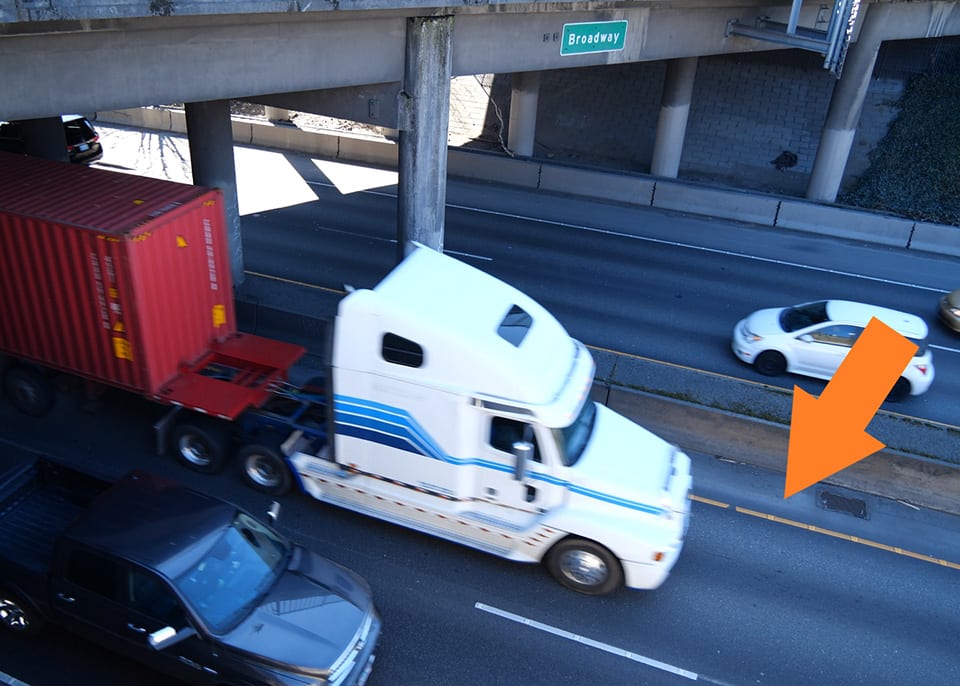About
News
HIGHWAY IMPROVEMENTS AIM TO REDUCE CRASHES BY UP TO 50% WITH AUXILIARY LANES AND FULL SHOULDERS
Did you know that crash rates in the Rose Quarter are 3.5 times higher than the statewide average? That’s why ODOT is making safety improvements. We’re upgrading this stretch of highway to include auxiliary lanes and full shoulders to reduce crashes by up to 50%.
How do full shoulders and auxiliary lanes improve safety?
Some sections of the current shoulder are 4 feet, far less than national standards, making it difficult for emergency vehicles to reach a crash or disabled car. Full shoulders ensure emergency responders can reach those in need, increasing survival rates after a crash. It’s the law to pull over when the police, firefighters and ambulance need to get through, and the current narrow shoulders make it difficult for cars and trucks to pull over to give first responders space to pass quickly.

The I-5 Rose Quarter is also the state’s top bottleneck, and nationally, it’s the 28th worst freight bottleneck. An auxiliary lane allows drivers more time and space to safely merge into the highway in their own lane, reducing bottlenecks. Entry and exit onto the freeway often cause bottlenecks that can lead to crashes. Research shows an auxiliary lane keeps drivers safe and traffic moving. Learn about how auxiliary lanes improved congestion and travel times on a recent project on I-205.
Together, auxiliary lanes and full shoulders in both directions of I-5 will reduce crashes and bottlenecks from drivers weaving in and out of lanes and provide safer areas for broken down vehicles to pull over or emergency responders to reach those in need. Watch this video from the Interstate Bridge Replacement Program. This video is intended to show how auxiliary lanes work and is not reflective of how many lanes will be included in the I-5 Rose Quarter Improvement Project. For the I-5 Rose Quarter Improvement Project, no new through lanes will be added. The existing two through lanes will remain and one new auxiliary lane will be added in each direction between I-84 and I-405.
Improving this stretch of highway is critical to keeping Oregonians safe, and the economy growing
I-5 is the main north-south route moving people and goods and connecting communities across the West Coast of the United States from Mexico to Canada. In the Portland region, I-5 between I-84 and I-405 is critical for truck freight and businesses moving goods, commuters traveling to and from Portland and locals traveling within the region. Improving this stretch of highway is critical to keeping Oregonians safe and the economy growing.
New graphic illustrates how the Proposed Hybrid 3 Concept will work to create better traffic flow
In 2021, project advisory committees and community members participated in a series of workshops exploring changes to the highway covers included in the initial environmental evaluation. Six highway cover design concepts were presented, and the Proposed Hybrid 3 Concept highway cover was chosen as best fitting the community’s needs. Below is a new graphic that shows how the driving experience will look under the Proposed Hybrid 3 Concept cover.

The Proposed Hybrid 3 Concept includes new multimodal facilities that will better connect the Albina neighborhood and make it easier to cross the highway. This option reflects the community’s preference to build a single large cover over I-5 to reconnect the local street grid and create a more vibrant street environment that supports neighborhood connectivity and walkability. It will also help maximize developable space on the highway cover that can support buildings up to three stories tall, with an option for building up to six stories, and provide economic opportunities for the Black community.

The Proposed Hybrid 3 Concept maintains the N. Flint Ave. connection and reconnects NE. Hancock St. to N. Hancock St. across I-5. It relocates the I-5 Southbound off-ramp at N. Broadway farther south to NE. Wheeler Ave. It will also connect the City of Portland’s proposed Green Loop for pedestrians and bicycles on Broadway and Weidler Streets, rather than through a separate off-street bridge. It also provides the structural support for three-story buildings on top, with an option for building up to six stories.
Benefits of the Proposed Hybrid 3 Concept highway cover:
- Maximize developable land and reconnect the local street grid.
- Reduce exposure to noise and pollution and create a more vibrant street environment.
- Preserve needed improvements to increase safety and traffic flow on the highway.
- Support neighborhood connectivity, community access and walkability.
- Provide opportunities for up to 3- and potentially 6-story buildings.
- Avoid impacts to historic properties and community redevelopment sites.

